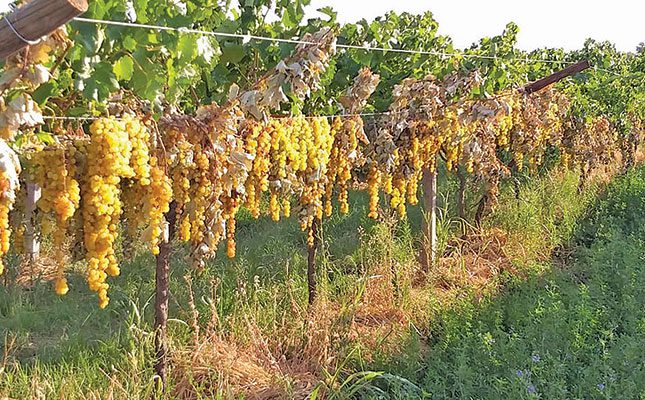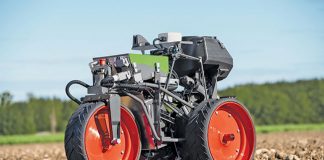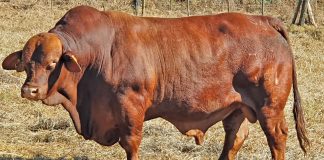
Photo: Glenneis Kriel
When Gawie Steyn, who farms near Kanoneiland in the Northern Cape, decided to switch to organic raisin production in 2008, his greatest initial challenge was to obtain enough organic material as soil cover.
Soil cover, he explains, is needed to reduce evaporation, which in turn improves the efficiency of flood irrigation and makes it easier to keep the top 20cm of soil saturated. This is important for farmers along the Orange River, as they take turns to irrigate their vineyards, which means that some receive water only every second week.
The soil cover also helps to buffer the soil against extreme temperatures, thereby encouraging the growth of a diversity of micro-organisms important for soil health and mineralisation.
Initially, Steyn considered buying straw or chaff to spread under the vine rows, but was unable to obtain any that was organically produced. He therefore made do with weeds already growing in the vineyards, but this failed to produce good results due to the hot climate.
“Our summer temperatures range from 22°C up to 42°C or higher, so the weeds decompose within a few days after being slashed and thrown onto the vine rows.”
Lucerne
In 2014, Steyn decided to opt for lucerne as a cover crop between the vineyards. “Lucerne is a clear winner under our conditions because it’s a perennial crop, it produces plenty of dry matter, and it’s a legume, which fixes nitrogen through symbiosis with rhizobium bacteria.
“Having flood irrigation also lessens competition for water between the vines and the lucerne.”
In addition, a perennial crop reduces cost, as the plants don’t have to be re-established each year, and there is less interference with the soil.
“The favourable environment we’re trying to create for soil organisms would be destroyed each time the land was worked to plant a new crop,” Steyn explains.
To ensure a good stand, he allows the lucerne to grow until it sets seed. In addition, rather than being shredded with a slasher, it is flattened with a roller to enable it to create a “thick blanket”. This is usually done before any major work, such as pruning or picking, so that workers can move easily in the vineyards. Steyn also flattens the lucerne when frost is forecast, usually in September and October.
“The weather services these days make it easy to identify times of high frost risk, so we flatten the lucerne a few days before frost is expected to lower the height at which the frost occurs. If we don’t do this, frost forms higher up, closer to the vine’s growing area,” he explains.
In another attempt to prevent damage, the vineyards are irrigated a day or two before the frost is due. Cultivars that bud later, such as Merbein, are planted in the lower, frost-prone areas, while Selma Pete, Sugra 39, Flame and Crimson are reserved for higher-lying areas.
Steyn says Flame and Crimson can also be used for table grape production, but he gave up this crop early in his farming career as it is difficult to ensure good-quality table grapes under flood irrigation. “A lot of precision is required, especially when it comes to irrigation.”
Mixed crops
Growing increasingly aware of the dangers of monocropping and the advantages of mixed crops, Steyn started adding chicory and Japanese radish to some of his vineyard blocks in 2019. Since then, he has included pod plants, clovers, vetch and certain grasses in the crop mixture, as well as a variety of herbs, including basil and fennel.
“I’ve not run into any pest or disease problems in the few vineyards where lucerne is still grown as a monocrop, but I’ll include other crops in these over time, as the benefits of mixed cover crops are undeniable.”
He refers to the Jena biodiversity experiment in Germany, which proved that the greater the variety of plants in the crop mixture, the better the results.
“A larger diversity in plant species and in the bio-population in and above the soil translates into more eco-services to the main crop. The vines have access to water and nutrients over a wider area, pests and problem organisms are kept under control more effectively, and the difference in root depths means that carbon is fixed at different levels in the soil.”
The carbon level of the soil has risen from between 0,4% and 0,7% to an average of about 1,5%. “My aim is to get the carbon levels as high as possible, because it has a direct impact on the water-holding capacity and fertility of the soil as well as soil health and structure.”
To ensure minimal disturbance of the soil during planting, Steyn built a two-row planter that forms a shallow furrow in which the seed is planted.
To determine how effective the mulch was at cooling the soil, he measured the soil temperature at various times during the day. The results showed that when the ambient temperature in summer was just over 40°C, the temperature in the barren soil climbed far above 40°C. Under the same conditions, the temperature of soil protected by cover crops remained at 23°C or 24°C, resulting in a far more favourable environment for micro-organisms.
The mulch proved equally effective in winter. Even when the ambient temperature dipped below zero, the soil temperature remained between 8°C and 10°C.
Compost
Steyn applies compost to boost soil nutrition and reduce his dependence on organic fertilisers. The compost is made from lucerne harvested from the young vineyards that don’t yet require a mulch, reeds removed from the canals, and sheep manure bought in
from farmers in the region.
A commercial pre-mixture of microbes is used to activate the compost and this is multiplied by aeration in 20ℓ cans. The microbes are supplied with food, such as molasses and fish hydrolysate, during the brewing process.
The compost is produced in static heaps, under black sheets to retain moisture, and is turned every second week with a tractor loader. It is usually ready within six to eight weeks, depending on climatic conditions.
The compost is spread at a rate of 8t/ ha to 10t/ ha on land set aside for new vineyards and is also applied at 4t/ha to 6t/ ha just after harvest to improve the yield of poorly performing vineyards.
He also applies compost tea to the vineyards to give the vines a biological boost and sprays sulphur from time to time. Fermented lucerne, which is high in protein and amino acids, is applied to vineyards from the start of the season until flowering to stimulate plant growth.
When vines appear to lose condition, Steyn and his team carry out a leaf analysis to identify nutritional deficiencies. These are then rectified through the use of organic foliar feeds, a wide variety of which is available on the market.
Pest management
Steyn does not include livestock in his production system, primarily because he is concerned about soil compaction.
“Flood irrigation leaves the soil quite wet, which will increase the risk of compaction if animals move over it,” he says.
He has experimented with various animals, but without success, He once used a herd
of 40 pigs to feed on the lucerne, but they ended up doing more damage than good.
Geese, which he thought would have a higher survival rate than chicken, also did not suit his system, as striped polecats stole their eggs and even preyed on the birds. He then tried goats, but their feeding caused much damage when the vineyards turned green, and he suspects the same would also occur if he used sheep or cattle.
The dry climatic conditions of the islands in the Orange River favour organic production, as they help to ensure minimal pest and disease problems. However, the uncharacteristic wet conditions experienced towards the end of the previous season resulted in a 50% harvest loss from downy mildew.
Steyn says this fungal disease not only resulted in the downgrading of grapes, but also stripped the vines of leaves, which meant there were insufficient reserves to grow a follow-up crop successfully.
“Organic solutions are available to prevent and manage downy mildew, but we’ve never had such a big outbreak before, so I didn’t expect this scale of damage.”
He adds that if faced with this problem again, he would start spraying copper compounds earlier and carry out applications. He would also apply the biological control agents he used, Bacillus amyloliquefaciens and B. subtilis, over shorter intervals.
Organic Production
Steyn points out that a switch to organic production usually coincides with a drop in yield. In his case, this lasted from two to four years, depending on the initial condition of the soils in the different vineyards. He adds that he would have been able to return to normal more quickly if he had introduced mixed cover crops and compost to the system at an earlier stage.
His organic vineyards produce between 30t/ha and 40t/ ha of wet grapes during an average year.
According to Steyn, the natural reaction of many farmers to the challenges of switching to organic farming is to yearn for their familiar conventional solutions. This urge has to be resisted, however, as it can destroy all the good that has been achieved.
“Going organic is a total mind-shift, because you can’t go back to your old ways. It also forces you to become more in tune with the production environment, as you need to identify risks early. There are no quick fixes, as in the case of conventional farming.”
His journey has been eased by the fact that there are a fairly large number of farmers in the Orange River Valley region who grow raisins organically.
“We started out as four, but these days there are quite a few of us. Having a large number of farmers means there are a lot of people whom you can bounce ideas off when you run into challenges.”
He adds that the manufacturers of crop protection products have also broadened their ranges to include softer and organic alternatives to conventional solutions.
Email Gawie Steyn at [email protected].












